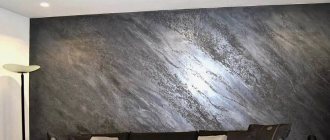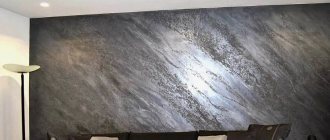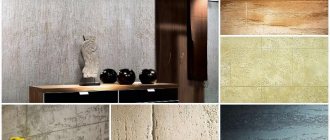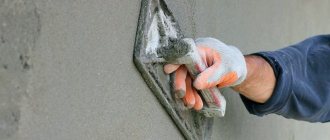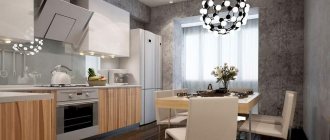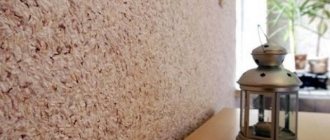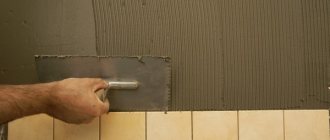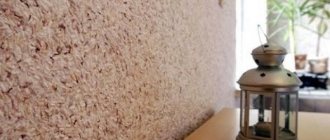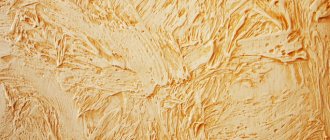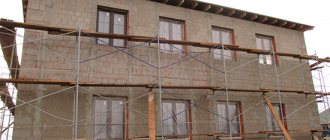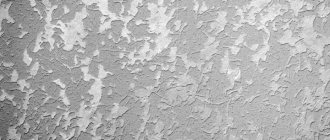Types of decorative plaster
In total, the finishing materials market includes over a dozen types of decorative plaster. Each option differs in composition, color content, viscosity, ductility, elasticity during application, texture, processing time, and storage. Some mixtures are perfect for finishing the facades of houses, others - for finishing interior spaces.
Marble plaster with silver plating Source ural-resurs.su
Decorative plaster with mother of pearl Source decorstudia.com.ua
Silk
Plaster to which mother-of-pearl is added looks like silk-screen printing on the wall. Texture here is achieved by adding small grains of stone chips or cellulose fibers. Silk plaster has earned high marks for decorativeness due to the delicate tints of the finished coating. Glare appears depending on the viewing angle where natural or artificial light falls. Silk plaster is ideal for the living room, bedroom, library, study, any room where there is a lot of upholstered furniture.
Decorative silk plaster in the living room Source zen.yandex.ru
Bark beetle
Some interior styles harmoniously accept surfaces with an imitation of artificial aging or a protective layer spoiled by a bark beetle. For these purposes, it is appropriate to use decorative plaster in the interior with its interesting name - bark beetle. Such finishes give the style concept greater authenticity, originality and antiquity. The basic basis of this technology is a granular mixture.
Decorative plaster - chaotic bark beetle Source drive2.ru
Mosaic
The appearance of single-color walls with small specks is mosaic decorative plaster. There are mixtures with different particle sizes and different colors. It is used to decorate walls both outside buildings, houses, and indoors. The surfaces are smooth and easy to clean. They are resistant to chips, scratches, and impacts from heavy objects. This plaster fits perfectly on almost any surface - concrete, brick, standard plaster, plasterboard panel material. Another plus is good ventilation.
Decorative mosaic plaster in a children's room Source mirplaster.by
Art concrete
Art concrete is a modern finishing material for walls, ceilings and floors. The mixture contains dry cement and gypsum powder. Various additives, fillers, dyes, and varnishes are also added to them. Soft plasters allow you to create original imitations of a concrete surface. They are decorated with rivets, pipes (especially in the loft style), images of slabs, stacked blocks (ideal for high-tech or minimalism styles).
Decorative plaster coating art-concrete in the interior of a bedroom in a minimalist style Source design-homes.ru
Application
The scope of use of plaster wall decoration is wide.
- Finishing of premises: residential, office and administrative, technical.
- Facade finishing.
The compositions used have different characteristics, depending on the conditions of subsequent operation.
- Mixtures for interior work - contain natural ingredients, are environmentally friendly and harmless.
- Compositions for external use are weather- and moisture-resistant, but contain unsafe special additives that provide exceptional characteristics. Not used indoors.
- Universal – combine the positive characteristics of the first two types: environmentally friendly + especially resistant to changes in humidity and temperature. In the home they are used for finishing non-residential premises: bathroom/shower rooms, toilets, kitchens. The special additives they contain with protective properties are environmentally friendly, but increase the cost of the plaster mixture.
Wanting to protect yourself from unpleasant surprises, before purchasing a composition, find out its suitability for the intended use.
Renovating should be fun.
Varieties by composition
Wall finishing material fillers have different features, functional and technical properties. If this is an option for decorating surfaces with gypsum or lime, then you can safely count on their strength. Such mixtures are usually used to finish the ceiling between beams in interior styles: Provence, country, chalet, vintage, retro, loft. Or when plastering sections of walls to look antique.
Decorative plaster in eco-style living room interior Source behance.net
Additional additives for decoration, creating an unusual coating:
- metallized threads;
- crushed shells;
- large cellulose fibers;
- pigments and colors.
Any decorative marble plaster in the living room, dining room, or hallway will not only beautifully recreate a beautiful pearlescent-shiny surface, but will also reliably protect the walls from various aggressive external factors. Neither mechanical damage, nor chemicals or detergents will damage the integrity of the coating. A number of other types of additives to plaster have the same or different properties.
Glossy marble plaster on the walls of the living room Source odnastroyka.ru
Textured mixture
Using this mixture, the desired pattern can be easily created. Well suited for beginners, the mixture is quite simple to work with, the effect is wonderful.
First you need to prime the surface, and after the soil dries, begin work.
Apply a thin layer of the solution to the entire wall. The main criterion for application is uniform layer thickness. For beginners, it is recommended to apply to a small area of the wall. The composition dries slowly, so you can slowly even out the thickness
Combination of decorative plaster with finishing
If you need to determine what types of finishes decorative plaster can be combined with in the bedroom, then you need to pay attention to the texture, color and pattern of the surface. Finishing refers to different coverings of walls, their projections, columns, niches, as well as details of the decoration of the ceiling, window or interior arched openings.
Textured decorative wall decoration harmoniously combines with smooth wallpaper Source kordecor.ru
If the room is being furnished in a loft style, then a structural mixture or art-concrete plaster will work well with brick or stone masonry. For living rooms in a classic, English or Italian style, a combination of smooth surfaces of ordinary plaster, painted in the same tone, with marble decorative plaster would be ideal.
Marble decorative plaster serves as an ideal background for artistic decoration in the form of fish Source delaisteny.ru
Any authentic or ethnic style will look harmonious if you combine decorative bark beetle plaster with wooden surfaces - ceiling beams, curtain rods, shelves, furniture.
Decorative bark beetle plaster fits perfectly into the interior with wooden doors, panels, ceilings and furniture Source homedezen.com
Venetian plaster looks accentuated with a plain ceiling (painted or stretched). Artistic parquet or beautiful tiles are ideal for this exquisite wall covering.
Light Venetian plaster on the walls harmonizes well with the parquet floor and white ceiling Source parketluxe.ru
Marseille wax is most suitable for interiors in Provence, Baroque, and Country styles. It completely replaces the wallpaper functions. This type of wall decoration will harmonize wonderfully with gypsum stucco molding and elegant forging elements.
Artistic stucco on Marseilles wax plaster Source vatikam.com
Mosaic plaster, granite (or any composite finishing material), stone, brickwork is an ideal solution for combining two different finishing methods. The granite slab also has inclusions in the mosaic, so they go well together.
Mosaic plaster in combination with white painted wooden panels Source vplate.ru
Sea Breeze plaster has a palette of over 45 color options. Among them, the most popular ones are sandy, golden, sea green, pearl, light and dark mother-of-pearl, white gold, silver, chameleon. This allows the material to be used in tandem with decorative wallpaper, photo wallpaper, airbrushing and other types of plasters.
Decorating the wall with sea breeze decorative plaster combines harmoniously with parquet. Source oboitop.com.ua
How to properly apply decorative plaster with your own hands
There are several additional types of decorative plaster application:
- fur coat;
- "lamb";
- terrazite;
- foam.
All of them are done using special tools and hand movements. You can work with both granular and fibrous mixtures. Grinding machines, textured rollers, comb spatulas, and textured sponges are used.
The decorative effect of bark beetle plaster varies. It depends on the direction of the working movement of the plasterer’s hand. The application of vertical bark beetles is done with sharp movements in a vertical straight line. Horizontal - horizontally (a trajectory in waves is allowed). Chaotic - application in a circular motion.
Important! The thickness of the layer should be the same as the thickness of the solid granules. Using a grater, they “scratch” the surface. This is how bark beetles are produced.
The principle of sgraffito plaster consists of several steps. First, a layer of the color that makes up the design itself or the background surrounding the design is applied. Allow the layer to dry and settle. Then a second layer of a contrasting color is applied. Here you can no longer wait for complete drying. You need to have time to cut the necessary contours to get the drawing.
Working with the second layer of decorative plaster sgraffiti Source mvestnik.ru
You can make the right craquelure by applying acrylic paint of the same color to the wall surface. Let everything dry thoroughly. Then a special mass is distributed over the painted surface. There are options for compositions that crack on their own after drying. The remaining plasters are heated with an industrial hair dryer. Cracks will form in heating areas. This method is needed when you need to achieve cracks only in some places.
Clear crack lines craquelure Source remont-book.com
Anyone can treat indoor walls with mosaic plaster. If, for example, sgraffito requires the skills of a master, then the mosaic mixture can simply be applied using a regular spatula and a metal grater.
Applying decorative mosaic plaster with a metal float Source kraski-net.ru
Before application, be sure to level the wall and then treat it with a primer. Sea Breeze should be applied correctly by spreading the topcoat over the wall. It is allowed to dry, and then decorative plaster is spread over the painted surface. It is better to repeat the pattern in increments of 1 square. At the end, let everything dry for 24 hours. Only after 2 weeks can the coating be washed with a damp cloth or sponge.
Perfectly applied sea breeze decorative plaster with the addition of silvering Source art—deco.com
Rules of care
Despite the fact that decorative plaster is a fairly durable and resistant coating, you should adhere to some rules for caring for it. The first year after application it does not require special care; it is enough to carry out wet cleaning with or without regular detergent.
In order to create an additional water-repellent and protective coating, the plaster can be coated with special wax. After several years of operation, this method will help renew the outer layer of the coating. After application, the wax layer is polished with a rag; further care should not include the use of solvents - only plain water or soap solution.
Glazing is another maintenance option; it adds shine and emphasizes the relief of the coating. Apply the special product with a mitt, or you can use a sponge or brush. If the coating has lost its appearance over time, or needs to be renewed, you can repaint it, remove it to the base and apply a new layer, or level it with putty over the coating.
